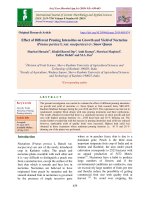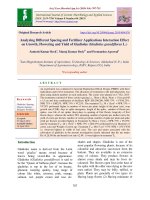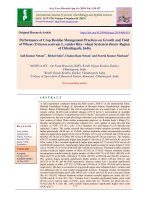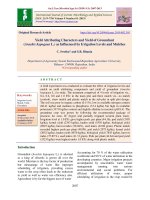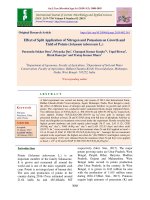Analyzing different spacing and fertilizer applications interaction effect on growth, flowering and yield of Gladiolus (Gladiolus grandiflorus L.)
Bạn đang xem bản rút gọn của tài liệu. Xem và tải ngay bản đầy đủ của tài liệu tại đây (246.57 KB, 9 trang )
Int.J.Curr.Microbiol.App.Sci (2019) 8(4): 707-715
International Journal of Current Microbiology and Applied Sciences
ISSN: 2319-7706 Volume 8 Number 04 (2019)
Journal homepage:
Original Research Article
/>
Analyzing Different Spacing and Fertilizer Applications Interaction Effect
on Growth, Flowering and Yield of Gladiolus (Gladiolus grandiflorus L.)
Santosh Kumar Beck1, Manoj Kumar Beck2* and Premanshu Agrawal1
1
Sam Higginbottom Institute of Agriculture, Technology & Sciences, Allahabad (U.P.), India
2
Department of Agrometeorology, IGKV, Raipur (CG), India
*Corresponding author
ABSTRACT
Keywords
Gladiolus, Spacing,
Organic manures,
Inorganic Fertilizer
Article Info
Accepted:
07 March 2019
Available Online:
10 April 2019
An experiment was conducted in factorial Randomized Block Design (FRBD) with three
replications and twelve treatments. The allocation of treatments to the individual plots was
done using random numbers in each replication. The corms were planted on 17 Oct. 2015.
The treatments consisted of three various spacing i.e., 30cm x 30cm, 30cm x 15cm and 40
x 15 cm and four combination of fertilizers RDF 200:200:200, NPK 75% + FYM 25%,
NPK 75% + GM25%, NPK 75% + VC25%. The treatment T12: 30 x 15cm2 + NPK 75% +
VC25% performed higher in number of leaves per plant, height of the plant (cm), crop
growth rate (CGR), days to spike emergence, length of the spike, number of florets per
spikes, vase life of cut spikes (days),days to opening of first florets, longevity of first
florets (days). whereas the earliest 50% sprouting, number of sprouts per mother corm, the
yield of corms per hectare, number of corms per plant, number of spike per plant and spike
yield per hectare recorded highest in Treatment T 8:30cm x 15cm + NPK 75% + VC25%
and the treatment T11: 40 x 15cm2 + NPK 75% + GM 25% performed best in Diameter of
corms (cm) and Weight of corms (g). Treatment T 10: 40x15 cm2 +75% NPK + 25% FYM
i.e. observed highest in width of leaf (cm). The cost and return associated with the
cultivation of gladiolus in the present investigation clearly indicated that the net return
Rs.14,28,591/ha and benefit cost ratio (2.89: 1) were highest in treatment T 8.
shades and shapes. Gladiolus is one of the
most popular flowering plants, because of its
colourful and attractive succession from the
bottom. They are available in an extensive
array of colours. They produce flowers in
almost every shade and may be bi-or tricoloured. The flowers open first at the base of
the spike with the older ones dying as the new
ones unfurl. They may be frilly, ruffled, or
plain. Plants are generally of two types (1)
Having large florets (2) Having miniature or
Introduction
Gladiolus name is derived from the Latin
word ‘gladius’ means sword because of
leaves being sword-like in appearance.
Gladiolus (Gladiolus grandiflorus) is said to
be the “Queen of bulbous plant”, because the
gladiolus is top in the list of its beauty,
glamour, keeping quality, long range of
colour like white, crimson, pink, orange,
salmon, red, purple cream and rose etc.
707
Int.J.Curr.Microbiol.App.Sci (2019) 8(4): 707-715
butterfly type flowers. Plant is straight and
leaves are also straight, spike stand straight
from the base. Beyond the limit or higher rate
of nitrogen delayed the time of flowering and
increased the spike length, weight and size of
corms. The higher rate of phosphorus and
potassium tended to improve the flower
quality.
experimental field was sandy loam in texture
and slightly alkaline in reaction. The soil was
low in organic carbon (0.45), available
nitrogen low (155.40), available phosphorus
medium (14.76), and available potassium
medium (139.82).
Materials and Methods
The data presented in Table 1 envisaged that
the fifty percent of sprouting the minimum
number of days (5.33) was taken by treatment
T8 (30 X 15 cm2 + 75% NPK + 25%
Vermicompost), whereas the maximum
number of days (6.46) for 50 percentages
sprouting was recorded in the treatment T1 (30
X 30 cm2 + 200:200:200 kg NPK). The
earliness in sprouting may be due to the
application of chemical fertilizer in
combination with FYM which promotes or
induces early sprouting of corm. This result is
confirmed with the findings of Bisen and
Barholia (1990) and Singh (1998) in potato
and gladiolus respectively.
Results and Discussion
Field preparation was done by ploughing the
field with mould board plough once, followed
by levelling and weeding manually. Then the
field was divided into three blocks spaced at
one meter distance. Each block was further
sub-divided into twelve sub-plots at a distance
of 0.5 m. The given amount of FYM,
Vermicompost and Goat manure was applied
in each sub plot treatment wise and then and
mixed properly. The usual method of
propagation of gladiolus is through corms and
cormels. Healthy corms size ranged between
3cm to 5cm were planted after treating with
Bavistin@
1gm/kg
corm.
FYM,
Vermicompost and Goat manure were given
as basal in the given plots treatment wise.
Recommended fertilizer of dozes Nitrogen
(N=0.130gm/plot) phosphorous (P=0.375gm/
plot) and potassium (K=0.99gm/plot) were
given during course of experiment. Full doses
of potassium and phosphorous were given as
basal application at the time of planting and
nitrogen was given in three split doses i.e. one
forth as basal and remaining three fourth in
two equal and split dozes i.e. one at 3 and
another at 6 leaf stages. Before planting of
corms in the soil, a soil sample was collected
from experimental field and analyzed for
physical-chemical characteristics. Gladiolus
may be grown on wide range of soils. Sandy
loam soil is suitable for good growth and
flowering. The most suitable pH range is 6-7.
The soil should be well drained and free from
soil borne disease. It is grown in open fields,
beds, pots and a border etc. The soil of
The data presented in Table 1 envisaged that
the maximum number of sprouts per mother
corm (1.46) was found in the treatment T8 (30
X 15 cm2 + 75% NPK + 25% Vermicompost).
The minimum number of sprouts per mother
corm (1.00) was recorded in treatment T1 (30
X 30 cm2 + 200:200:200 kg NPK). The
superiority of treatment T8 over the rest of the
treatments might be due to availability of
optimum amount of nutrient from inorganic
fertilizer in combination with Vermicopost.
This result is in close conformity with the
findings of Singh and Singh (1971).
The data presented in Table 1 envisaged that
the number of leaves per plant was counted at
30, 60 and 90 days after planting. The
maximum number of leaves was observed
(10.40) in treatment T12 (40x15 cm2 + NPK
75% + Vermicompost 25%). Minimum
number of leaves per plant was observed
708
Int.J.Curr.Microbiol.App.Sci (2019) 8(4): 707-715
(6.86) in treatment T1 (30 X 30 cm2 +
200:200:200 kg NPK). This might be due to
continues availability of essential nutrient to
the crop by the application of inorganic
fertilizer in combination with organic
Vermicompost. These observations followed
the results of Ahmed et al., (2004).
Findings are in conformity with the findings
of Singh and Bijimol (2000).
The data presented in Table 2 envisaged that
the maximum longevity of first florets in Al2
(So4)2 200 ppm (5.74) was obtained in the
treatment T12 (40x15 cm2 + NPK 75% +
Vermicompost 25%) whereas the minimum
longevity was found in the treatment T1 (30 X
30 cm2 + 200:200:200 kg NPK) (4.11 days). It
may be due to the exogenous supply of
Al2(SO4)2 & Sucrose which replaced the
depleted endogenous carbohydrate, utilized
during the postharvest life of lower and
thereby enhanced vase life Kumar (2005).
The data presented in Table 1 envisaged that
the data on height of the plant was recorded at
30, 60 and 90 days after planting. The
maximum height of the plant was observed
(124.13 cm) in treatment T12 (40x15 cm2 +
NPK 75% + Vermicompost 25%) and it was
significantly superior over all of the
treatments. Minimum height of the plant was
noted (117.66 cm) in treatment T1 (30 X 30
cm2 + 200:200:200 kg NPK). The maximum
height of plant under the treatment T12 might
be associated with the availability of optimum
nutrient to the plant throughout the growth
period by the application of inorganic
fertilizer in combination with Vermicompost.
This is in accordance with the findings of
Widjajanto and Widodo (1982).
The data presented in Table 2 envisaged that
the minimum number of days to spike
emergence 64.40 days was taken by the
treatment T12 (40x15 cm2 + NPK 75% +
Vermicompost 25%). The maximum number
of days to spike emergence 77.46 days. Was
taken by the treatment T1 (30 X 30 cm2 +
200:200:200 kg NPK) The earliness in spike
emergence
by
the
application
of
Vermicompost in combination of inorganic
fertilizer may be due to optimum availability
of nutrients to the plant due to which plant
completed their vegetative growth soon
resulting in early spike emergence. These
results are in close conformity with the
findings of Ahmed et al., (2004). They
observed that the treatment which was
comprised of 20 g urea/m2 + 40g (DAP)/m2
+ 4kg FYM/m2 taken minimum number of
days for emergence flower bud in Dahlia.
The data presented in Table 1 envisaged that
the maximum leaf width (3.69) was obtained
in treatment T10 (40X15 cm2 + NPK 75% +
FYM 25%) and the treatment T1 (30 X 30 cm2
+ 200:200:200 kg NPK) recorded the
minimum leaf width (3.05).
Similar result was recorded by Shankar
(2001). He observed that the leaf breadth of
gladiolus was maximum in the treatment
NPK@ 40:20:20g/m2, Singh and Bijimol
(2000) (Tuberose).
The data presented in Table 2 envisaged that
the maximum length of spike (101. 35cm)
was recorded in the treatment T12. The
minimum length of the spike 60.82cm.was
obtained in treatment T1 (30 X 30 cm2 +
200:200:200 kg NPK) The maximum length
of the spike in treatment T12 may be due to
the availability of sufficient amount of
nitrogen in different phases of growth and
The data presented in Table 2 envisaged that
the days to opening of first florets was
recorded minimum in treatment T12 (40x15
cm2 + NPK 75% + Vermicompost 25%)
(16.00) and minimum number of florets per
spikes was recorded in the treatment T1 (30 X
30 cm2 + 200:200:200 kg NPK) (11.02).
709
Int.J.Curr.Microbiol.App.Sci (2019) 8(4): 707-715
development of plants which promotes the
length of the spike. Similar result was
recorded by Gupta et al., (2008). They
reported that the maximum length of the spike
in gladiolus was obtained by applying
Vermicompost @ 2.5kg/m2.
kg NPK) (3.35cm). It may be due to Goat
manure and other essential nutrient NPK and
proper spacing was regularly available to the
plant at critical stage of growth and
development of corm which, in turn, resulted
in faster and better development of corm. This
result is in close agreement with the findings
of Varu et al., (1994).
The data presented in Table 2 envisaged that
the maximum number of florets per spike
16.00 was counted in the treatment T12 (40x15
cm2 + NPK 75% + Vermicompost 25%) and it
was significantly superior over all the
treatments. The minimum number of florets
per spike (11.02) was observed in the
treatment T1 (30 X 30 cm2 + 200:200:200 kg
NPK) The superiority of treatment T12 for
number of florets over the other treatments
may be due to the availability of organic and
inorganic fertilizers and other essential
nutrients for longer period at optimum level
resulting in more number of florets per spike.
This result is in close agreement with the
findings of Ahmed et al., (2004).
The data presented in Table 3 envisaged that
the maximum weight per corm was recorded
in the treatment T11 (40x15cm2 + 75% NPK +
25 % Goat manure) (66.69g.) whereas
minimum weight per corm was found in the
treatment T1 (30 X 30 cm2 + 200:200:200 kg
NPK) (32.43g). Similar result was obtained
by Varu et al., (1994).
The data presented in Table 3 envisaged that
the no. of spike per plant was recorded
maximum in Treatment T8 (30 X 15 cm2 +
75% NPK + 25% Vermicompost) (1.29) and
spike was obtained minimum in Treatment T1
(30 X 30 cm2 + 200:200:200 kg NPK) (1.00).
This result is in close agreement with the
findings of Sud et al., (2010).
The data presented in Table 2 envisaged that
the Treatment T12 (40x15 cm2 + NPK 75% +
Vermicompost 25%) had the longest vase
(13.13days) in Al2 SO4)2 - 200ppm where as
the minimum vase life 9.96 days in distilled
water was obtained in treatment T1 (30 X 30
cm2 + 200:200:200 kg NPK). The maximum
vase life in treatment T12 may be due to the
positive effect of inorganic nitrogen in
combination
with
organic
manure
Vermicompost on the vase life and also due to
more accumulation of carbohydrate which
increased the vase life of cut spikes. Similar
findings are reported by Narendra et al.,
(2013).
The data presented in Table 3 envisaged that
the highest no. Of corm was obtained in
treatment T8 (30 X 15 cm2 + 75% NPK + 25%
Vermicompost) (1.28) and minimum no. of
corm was found in treatment T1 (30 X 30 cm2
+ 200:200:200 kg NPK) (1.00). It may be due
to higher germination percentage of corm
with the application of inorganic fertilizer in
combination with Vermicompost and proper
spacing (30x15cm2). This result is in close
agreement with the findings of Sud et al.,
(2010).
The data presented in Table 3 envisaged that
the maximum diameter of corm was noticed
in the treatment T11 40x15cm2 + 75% NPK +
25 % Goat manure) (5.66 cm) whereas the
minimum diameter of corm was obtained in
the treatment T1 (30 X 30 cm2 + 200:200:200
The data presented in Table 3 envisaged that
the highest yield of spike per hectare was
obtained in the treatment T8 (30 X 15 cm2 +
75% NPK + 25% Vermicompost) (2,60,000)
and minimum spike yield was recorded in
treatment T1 (30 X 30 cm2 + 200:200:200 kg
710
Int.J.Curr.Microbiol.App.Sci (2019) 8(4): 707-715
NPK) (1,11,111) The greater spike yield per
hectare might be due to an optimum
combination of fertilizers and manures with
short spacing. The similar increase in flower
yield due to increase in number of sprouts and
spike length. Similar findings are reported by
Radhika et al., (2010).
carbohydrate and protein resulting in better
vegetative growth of plant. This probably
helped in better tuberization of corm and
increase their weight and size may be due to
higher germination percentage of corm with
the application of inorganic fertilizer in
combination with Vermicompost and proper
spacing (30x15cm2). This result is in close
agreement with the findings of Hassandokht
and Kashi (2000).
The data presented in Table 3 envisaged that
the
maximum
yield
of
corms
2,67407corms/ha. recorded in the treatment
T8 (30 X 15 cm2 + 75% NPK + 25%
Vermicompost) which was significantly
superior over all the treatment. The minimum
yield of corms (1, 11111) corms/ha was found
in the treatment T1 (30 X 30 cm2 +
200:200:200 kg NPK). Increase in yield with
treatment T8 may be due to assimilation of
The highest benefit cost ratio was found in the
treatment T12 (40x15 cm2 + NPK 75% +
Vermicompost 25%) (3.50:1) whereas the
lowest benefit cost ratio was recorded in the
treatment T1 (30 X 30 cm2 + 200:200:200 kg
NPK) (2.77:1).
Table.1 Combined effect of planting density and organic and inorganic fertilizer on growth
characteristics of gladiolus
Growth Characteristics
Treatments
Days to 50%
sprouting
Number of
sprouts per corm
Plant height
(cm)
Number of leaves
per plant
Width of the leaf
(cm)
S1 F1 (T1)
6.46
1
117.66
6.86
3.05
S1 F2 (T2)
5.6
1.13
120.8
7.46
3.28
S1 F3 (T3)
6.06
1.16
119.46
7.2
3.42
S1 F4 (T4)
5.53
1.26
119
7.33
3.42
S2 F1 (T5)
5.73
1.33
121.93
8.4
3.42
S2 F2 (T6)
5.46
1.26
118.2
7.4
3.40
S2 F3 (T7)
6.26
1.43
123.2
9.7
3.63
S2 F4 (T8)
5.33
1.46
119.86
7.86
3.38
S3 F1 (T9)
5.73
1.26
118.11
7.6
3.60
S3 F2 (T10)
5.8
1.26
120.86
7.73
3.69
S3 F3 (T11)
5.4
1.4
119.75
7.46
3.39
S3 F4 (T12)
5.66
1.26
124.13
10.4
3.47
S1: 30cm x 30cm, S2 : 30cm x 15cm
25%, F4: NPK 75% + VC 25%
, S3: 40cm x 15cm, F1: 200:200:200 kg/h, F2: NPK 75% + FYM 25%, F3: NPK 75% + GM
711
Int.J.Curr.Microbiol.App.Sci (2019) 8(4): 707-715
Table.2 Combined effect of planting density and organic and inorganic fertilizer on floral characteristics of gladiolus
Floral Characteristics
Treatments
Days to Spike
Opening
Spike
Number of
Longevity of
Vase Life of
No. of spikes per
initiation
Of first
length
florets per
first floret
Spikes In
plant
floret
(cm)
spike
In Al2(so4)3
Al2(so4)3
(days)
(days)
S1 F1 (T1)
77.46
94.35
60.81
11.02
4.11
10.66
1
S1 F2 (T2)
70.19
83.73
80.78
11.87
4.86
11.66
1.15
S1 F3 (T3)
75.39
84.66
64.83
11.57
4.45
11
1.11
S1 F4 (T4)
72.3
85.24
72.75
14.45
4.90
11.33
1.07
S2 F1 (T5)
65.57
89.24
65.83
13.07
4.53
12
1.00
S2 F2 (T6)
72.53
89.34
99.35
12.27
4.49
12
1.15
S2 F3 (T7)
77.30
90.01
100.39
13.34
5.44
13
1.17
S2 F4 (T8)
67.44
88.12
87.32
14.35
5.21
12
1.29
S3 F1 (T9)
76.35
89.66
87.40
12.44
4.86
12.33
1.01
S3 F2 (T10)
67.39
80.77
67.09
12.01
5.13
12
1.03
S3 F3 (T11)
65.43
88.59
86.63
12.07
4.68
11.66
1.15
S3 F4 (T12)
64.40
80.33
101.34
16
5.74
13.13
1.08
S1: 30cm x 30cm, S2: 30cm x 15cm , S3: 40cm x 15cm, F1: 200:200:200 kg/h, F2: NPK 75% + FYM 25%, F3: NPK 75% + GM 25%, F4: NPK 75% + VC 25%
712
Int.J.Curr.Microbiol.App.Sci (2019) 8(4): 707-715
Table.3 Combined effect of planting density and organic and inorganic fertilizer on yield characteristics of gladiolus
YieldCharacteristics
Treatments
Diameter of
Weight of
No. of Spike per
Number of
Spike yield per
Corm yield per
corm (cm)
Corms (g)
plant
Corms per
hectare
hectare
plant
('000 Hectare)
S1 F1 (T1)
3.35
32.43
1
1.01
111.111
111111
S1 F2 (T2)
4.87
54.17
1.15
1.06
128.148
211481
S1 F3 (T3)
5.40
58.03
1.11
1.15
124.074
139629
S1 F4 (T4)
5.41
60.63
1.07
1.07
120.37
124074
S2 F1 (T5)
4.38
50.19
1.00
1.00
223.703
223703
S2 F2 (T6)
4.55
56.98
1.15
1.15
240
232592
S2 F3 (T7)
5.59
63.55
1.17
1.17
255.555
255555
S2 F4 (T8)
3.54
42.98
1.29
1.28
260.000
267407
S3 F1 (T9)
4.54
53.68
1.01
1
168.333
168333
S3 F2 (T10)
3.85
38.92
1.03
1.15
172.777
177777
S3 F3 (T11)
5.65
66.69
1.15
1.11
191.666
191666
S3 F4 (T12)
4.51
52.70
1.08
1.07
239.999
213333
S1: 30cm x 30cm, S2: 30cm x 15cm , S3: 40cm x 15cm, F1: 200:200:200 kg/h, F2 : NPK 75% + FYM 25%, F3: NPK 75% + GM 25%, F4: NPK 75% + VC 25%
713
Int.J.Curr.Microbiol.App.Sci (2019) 8(4): 707-715
On the basis of this research, treatment T12
(40x15 cm2 + NPK 75% + Vermicompost
25%) performed higher in number of leaves
per plant, height of the plant (cm),days to
spike emergence, length of the spike, number
of florets per spikes, vase life of cut spikes
(days),days to opening of first florets,
longevity of first florets(days).Whereas the
earliest 50% sprouting, number of sprouts per
mother corm, the yield of corms per hectare,
spike yield per hectare, was recorded highest
in Treatment T8 (30 X 15 cm2 + 75% NPK +
25% Vermicompost) and the treatment T11
(40x15cm2 + 75% NPK + 25 % Goat manure)
performed best in Diameter of corms (cm)
and Weight of corms (g). These characters
may affect significantly due to different
combination of spacing and source of
fertilizer. However, since this is based on one
season experiment, further trials may be
needed to substantiate the results.
Kumar, R. (2005). Effect of integrated use of
chemical fertilizers, biofertilizers and
biostimulants in gladiolus (Gladiolus
grandiflorus L.) cv. Sancerre.
Progressive Horticulture Vol. 43(1):
149-152,
Narendra, C., Swaroop, K., Janakiram, T.,
Biswas, D.R. and Singh, G. (2013),
Effect
of
integrated
nutrient
management on vegetative growth and
flowering characters of gladiolus.
Indian J. Hort. 70(1), March 2013:
156-159.
Radhika, M., Patel, H. C., Nayee, D.D., and
Sitapara, H.H. (2010), Effect of
integrated nutrient management on
growth and yield of African marigold
(Tagetes erecta L.) cv. 'Local' under
middle
Gujarat
agro-climatic
conditions.
Asian
Journal
of
Horticulture; 2010.5(2):347-349.
Shankar, D. 2001. Studies on response of
NPK and FYM alone, and in
combination on production of
gladiolus corms through cormels.
M.Sc. (Ag) Thesis submitted to Indira
Gandhi Krishi Vishwavidyalaya,
Raipur, Chattisgarh, p. 62.
Singh, K.P. 1998. Response of graded level
and split doses of nitrogen application
in multiplication of gladiolus corm
through cormels, Advances in Plant
Science, 11(2): 305- 307.
Singh, S.P. and Singh, R., P. 1971. Response
of potato (Solanum tuberosum L.)
variety Kufri Sindhuri to farm yard
manure and fertilizer nitrogen. Journal
of Plant Science, 3: 108- 112.
Singh, A., K. and Bijimol, G. (2000). Effect
of spacing and nitrogen on gladiolus.
J. Ornametal Hort., New Series, 6(1):
73-75.
Sud, K.C., Grewal, J.S. and Trehan, S.P.
2010. Effect of farm yard manure and
nitrogen
on
potato
(Solanum
tuberosum)
production
and
References
Ahmed, M., Khan, M., F., Hamid, A. and
Hussain, A. 2004. Effect of urea, DAP
and FYM on growth and flowering of
dahlia. International Journal of
Agriculture and Biology, 6(2): 393395.
Bisen, A.L. and Barholia, A., K. 1990. Note
on response of potato to methods and
nitrogen application. Indian Journal of
Horticulture, 47(4): 424- 426.
Gupta, P., Rajwal, N, Dhaka, V., K. and
Rajwal, D. 2008. Effect of different
levels of vermicompost, NPK and
FYM on performance of gladiolus
(Gladiolus grandiflorus L.) cv. happy
end. Asian Journal of Horticulture,
3(1): 142-143.
Hassandokht,
M.R.
and
Kashi,
A.
2000.Effects of farmyard manure and
nitrogen application on the quantity
and quality of potato crop. Seed and
Plant Journal, 15(4): 323-330.
714
Int.J.Curr.Microbiol.App.Sci (2019) 8(4): 707-715
phosphorus and potassium availability
in hill soils of Shimla. Indian Journal
of Agricultural Sciences, 60(8): 529532.
Varu, D.K., Vhora, P.H. and Kikani, K.P.
1994. Effect of organic and inorganic
fertilizers
on
onion.
Gujarat
Agricultural University Research
Journal 14 (1): 128-131.
Widjajanto, D.D. and Widodo, 1982.The
effect of farmyard manure and
nitrogen fertilizer on growth and
production of potatoes. Bulletin Pen.
How to cite this article:
Santosh Kumar Beck, Manoj Kumar Beck and Premanshu Agrawal. 2019. Analyzing Different
Spacing and Fertilizer Applications Interaction Effect on Growth, Flowering and Yield of
Gladiolus (Gladiolus grandiflorus L.). Int.J.Curr.Microbiol.App.Sci. 8(04): 707-715.
doi: />
715

![Growth and yield of Ashwagandha [Withania somnifera (L.)] as influenced by different intercropping system in Kymore plateau of Madhya Pradesh](https://media.store123doc.com/images/document/2020_01/09/medium_vsb1578562778.jpg)
